
Proper care for fragrant dracaena at home. Dracaena is fragrant. Care. Unusual flowering
Fragrant dracaena is one of the brightest representatives of the Agave family. Thanks to an old legend in the countries of South America, the dracaena is called the "tree of happiness." It is believed that Dracaena is a tree with positive energy. This species has long, wide dark green leaves from 30 cm long with light veins along the entire leaf. The most popular type is Massagena.
Fragrant dracaena, even alone, can decorate any home interior. 
Dracaena fragrant (Massagena). Care.
- Like many representatives of the dracaena family, Massagena does not tolerate waterlogging of the soil. The plant needs to be watered rarely, but plentifully. If you water Dracaena more often than required, then root rot is inevitable. In the future, rot will go down the trunk. First, this will affect the leaves of the plant - spots will appear, then the leaves will begin to die and crumble. In watering, you need to find a middle ground, so to speak, do not allow the soil to dry out completely, but also prevent waterlogging. It is correct to water Dracaena fragrant once or twice a month in winter and a little more often (once every one and a half weeks) in the warm season, but water it so that the whole lump is evenly saturated with water and excess moisture comes out of the drainage holes, then drain the remaining water from a saucer. Water for irrigation should be used soft, separated, and only at room temperature.
- Since fragrant Dracaena is quite bulky, it is better to transplant it into a heavy ceramic pot, the walls inside the pot should not be glazed. The pot can be chosen low, but stable. Replant the plant no more than once every 3 years, preferably in the spring, in a specially designed soil for Dracaena or in another heavy soil.
- Dracaena loves fairly bright lighting, but it must be shaded from direct sunlight, otherwise the leaves of the plant will get burned and appearance will lose its decorative and attractiveness. If she lacks lighting, you will notice this by the state of the leaves: the leaves from a dark green color will turn into dark green without veins and lose their “zest”. In this case, Dracaena needs to be moved closer to the window or provided with additional artificial lighting.
- These plants do not tolerate dry air well. The first sign of a lack of moist air is the dry tips of the leaves. You can correct the situation with a humidifier or spraying the plant with warm soft water from a spray bottle in the morning and evening. In no case should you do this during the day, because even small droplets of water can work as a "lens effect" and the leaves will get burned. Dracaena fragrant responds very well to a warm shower. Periodically, in the warm season, she can take a shower, after covering the land lump with a bag. After a shower, your plant will look much fresher.
- Most Dracaena prefer a cool wintering t + 15C (not lower than + 12C) at night and in the spring and summer the optimum daytime temperature is + 25C, but they can withstand high temperatures up to + 30C.
- It is recommended to feed the plant year-round, in summer - once every 2 weeks with complex fertilizers, in winter - once a month.

Although the encyclopedia contains information that at home this plant blooms extremely rarely, I was able to make the above-described type of Dracaena bloom. The aroma of Dracaena is intense, fragrant and quite pleasant.
Dracaena fragrant (lat. Dracaena Fragrans) or dracaena fragrans is a very beautiful home plant, which is popularly called the "Tree of Happiness". Today it is very popular to grow it in houses, apartments, and even offices. This is not a whimsical plant, but for many, fragrant dracaena feels completely uncomfortable, grows poorly and does not bloom. The tree of happiness has received such a popular name because of its unique properties.
Fragrant dracaena is a natural indicator of emotions, for example, if silence and tranquility reign in the room in which it grows, then this plant feels great and constantly pleases its owners beautiful flowers. And vice versa, if there are scandals or just a tense situation in the room, then the dracaena feels bad, stops growing and gradually dies.
There is also a legend that says that in order to win the heart of the priest's daughter, a warrior in love had to grow leaves and flowers on a stick in 5 days. If this did not happen, then he was threatened with the death penalty. But the love of the guy and the girl was so strong that it made the stick bloom, after which there was a magnificent wedding. The consequence of this legend was the popular name of dracaena - the tree of happiness.
Information about dracaena fragrant.
Dracaena fragrant is an evergreen shrub that belongs to the genus Dracenova and comes from the Agave family. In total, scientists know about 150 species of these plants. This plant is native to tropical parts of Asia and Africa. IN natural conditions this dracaena grows up to 6 m in height and blooms with beautiful white and very fragrant flowers, which is why it was called "fragrant".
Popular varieties of dracaena.
Dracaena has long been grown in a pot at home. Flower growers contain many varieties of this plant, differing from each other in their size and color of the leaves, which are variegated, plain, with a border or striped.
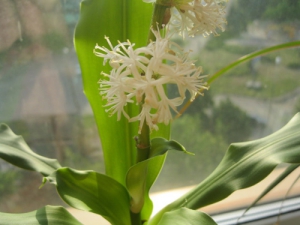
The most popular varieties of dracaena that are grown at home include:
- Dracaena Massangeana (lat. Dracaena Massangeana) grows up to 1.5 m in height and grows in the form of a bush consisting of palm trees. This plant has variegated leaves with a wide yellow stripe in the center and small stripes along the edges.
- Dracaena Compacta (lat. Dracaena Compacta) - a small plant with a shortened stem and dark green leaves collected in a fairly dense bunch. This variety with monotonous leaves is valued for its ability to grow in low light conditions. There is also a variety of this species Dracaena Compacta Variegata (lat. Dracaena Compacta Variegata), differing only in that there are longitudinal yellow stripes on the leaves.
- Dracaena Victoria (lat. Dracaena Victoria). This is very beautiful plant from beautiful leaves, along the edges of which golden-yellow rather wide stripes pass.
- Dracaena lindeni(lat. Dracaena Lindenii) has dark green leaves with white or yellow wide stripes along the edges.
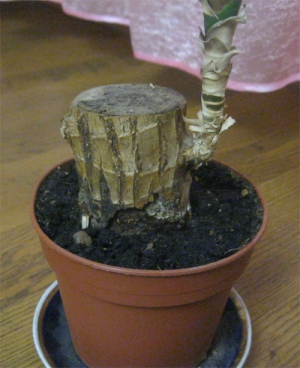
Also, some growers can meet Kanzi dracaena, Compact dracaena, Lemon Lime dracaena and a very miniature (up to 20 cm in height) Surprise dracaena.
Caring for fragrant dracaena at home.
The tree of happiness is not whimsical and proper care feels great.
Lighting for fragrant dracaena.
Some species of this plant (green!) Feel great in partial shade, but it is preferable to place a pot with dracaena in the light, but without direct sunlight. Variegated species of happiness trees should not be grown in partial shade or permanent shade, as they may lose their bright colours. In the summer, it is recommended to take these plants to the balcony or garden, but they must be shaded.
Best of all, dracaena will feel on the windowsills, the windows of which face east or southwest. In winter, when there is little light, the plant must be placed as close as possible to the window or artificial lighting should be made for it.
Temperature regime of cultivation for fragrant dracaena.
The best summer temperature for growing a tree of happiness is from 18 0 C to 25 0 C. For variegated dracaena, this temperature must be maintained all year round, and for the rest in the winter, it must be reduced to 15-17 0 C, but in no case lower.
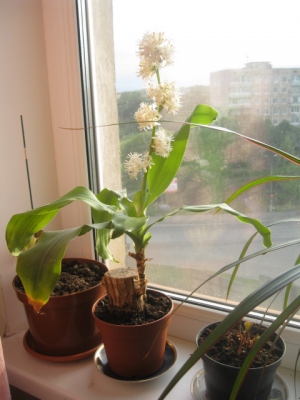
Watering fragrant dracaena.
During wakefulness (from spring to autumn), the tree of happiness needs abundant watering, in which the soil will be constantly moistened.
During the sleep period (from mid-autumn to early spring), fragrant dracaena needs to be watered less, that is, let the top layer of soil dry out. If at this time the plant is located near the heating partings, then it needs to be watered a little more often.
Air humidity for fragrant dracaena.
With dry indoor air, the tips of the leaves of the tree of happiness can dry out, then they turn completely yellow and fall off. To avoid this, put the pot on a pallet with wet claydite. You can also wipe the leaves with a soft, damp cloth or occasionally "rinse" the plant under a warm shower, but then be sure to shake off the water from it.
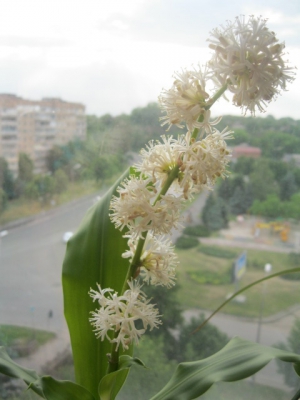
Like pandanus, it is not recommended to spray dracaena from a spray bottle, as water can remain between the leaves, then dust gets there and begins to rot, which leads to the death of the plant.
Soil for fragrant dracaena.
For a tree of happiness, high-quality soil is needed, consisting of compost, deciduous and sod land with the addition of peat and clean coarse sand. If you have all these ingredients, then mix them in equal proportions. Also, for the prevention of root diseases, you can add a little charcoal, and for looseness of the soil - brick chips.
Fragrant dracaena feels very good in quality mixtures that are sold in flower shops and are intended for ornamental deciduous plants. In this soil, add coarse clean sand in a 1: 1 ratio.
Top dressing fragrant dracaena.
To feed the plant, it is best to use special store-bought fertilizers that are designed for palm trees or dracaena.
From the beginning of March to the end of September, fragrant dracaena must be fed 2 times a month, and the rest of the time - half doses and no more than 1 time per month.
Transplantation of fragrant dracaena.
Dracaena are transplanted quite rarely: young individuals - 1 time in 2 years, and adults no more than 1 time in 3 years. If the plant is large, then it can not be transplanted at all, but simply replace the topsoil with a new one.
Dracaena are transplanted very carefully using the transshipment method. This will help prevent damage to the roots.
The plant needs good drainage to grow. To do this, for small dracaena, pour up to 1 cm of expanded clay on the bottom of the pot. For adults and bulky individuals, medium-sized stones can be poured onto the bottom of the pot as drainage, or one large one can be placed, and small ones can be poured around it.
Immediately after transplanting, the plant must be watered abundantly so that the whole earth is wet. The next watering is not so strong. A transplanted fragrant dracaena can be fertilized only after the appearance of a new leading (central) leaf.
To transplant the plant, use the soil described in the paragraph "Soil for fragrant dracaena".
Shaping and pruning fragrant dracaena.
If desired, a multi-stem tree can be formed from a straight single-stem dracaena tree. This should be done in spring or summer, that is, when the plant is actively growing.
To form several trunks with a sharp knife or secateurs, the upper part of the plant is cut off 10-15 cm below the leaves. The place of the cut of the lower part remaining in the pot is sprinkled with well-ground activated charcoal and set in a warm, dark place. At this time, it is practically not necessary to water the dracaena, because due to the lack of leaves, it will absorb water very weakly. In about a month, several dormant buds will start on this part of the plant. Usually there are no more than 3, but occasionally there are more (up to 7 pieces). If there are a lot of young stems, then when they reach 5-10 cm in length, the extra ones can be cut off along with the trunk and planted separately. After a while, young leaves will appear on the remaining stems. Thus, you will get a multi-stemmed dracaena.
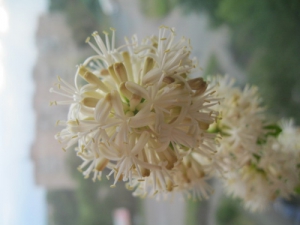
The upper part of the plant must be placed in an empty pot to dry for a couple of days, and then planted in a wet mixture consisting of equal proportions of sand and peat. For better rooting, I recommend collecting the leaves in bunches by tying them with a ribbon. You can’t use a thread for this, as it will ruin the leaves. Then, to create greenhouse conditions, put a transparent plastic bag on the dracaena or (if the plant is small) a cut plastic bottle. In this form, put the plant in a bright, warm place and ventilate it at least once a day, removing the greenhouse for 20-30 minutes.
Reproduction of fragrant dracaena.
This plant is propagated by cuttings. To do this, cut off the upper part of the plant 10-15 cm under the leaves. Then for a couple of days, put it upright in an empty pot so that the glass has excess moisture. After drying, plant the dracaena in a moist soil mixture consisting of 50% sand and 50% peat, and cover with a greenhouse. In this form, grow the plant in a warm, bright place, removing the greenhouse for ventilation for 30 minutes every day.
Pests and diseases of fragrant dracaena.
The tips of the dracaena leaves dry up.
In most cases, this is due to poor watering. It can also be due to dry air or drafts.
Dracaena leaves turn yellow and wither.
This can occur due to constant waterlogging, in which the roots deteriorate, due to a lack of nutrients in the soil, or when direct sunlight hits the plant.
The plant can be attacked by mealybugs, scale insects and false scale insects, aphids, as well as spider mites.
For the prevention and treatment of these diseases, it is recommended to apply warm showers and wipe the leaves with a soft, damp cloth.
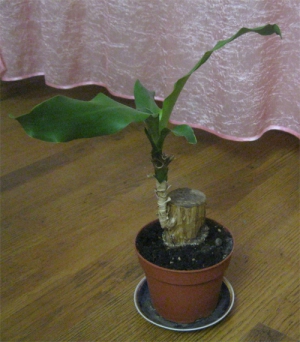
Dracaena came into our homes from the subtropical and tropical forests of Africa and South Asia. Often in stores, cordilins and dracaena are sold as the same plant for growing at home. The similarity of these two plants is that they both have narrow, elongated green leaves. The only difference between these plants can be seen only in the root: cordilins differ in the formation of underground shoots with buds and underground thickened stems - rhizomes, it is from them that new plants grow; dracaena does not have a rhizome at all, the roots of the plant are perennial yellowish in color, located parallel on the leaf, the veins converge at its ends. Because of the bunch of leaves at the top, the leafless trunk of cordilina and dracaena is also called false palm trees. Under natural conditions, dracaena can bloom. The dracaena flower looks more like a broom with small white flowers, but at home, the dracaena is not bred like flowering plant, but as an original single plant for the interior of living rooms and halls.
Varieties and types of dracaena
More than a hundred species of dracaena are known in nature, but only a few of this hundred are used as “indoor dracaena”, the popular dragon tree is dracaena draco. In conditions indoor cultivation This dracaena can reach 1.5 m in height. In general, the leaves of this plant are green in color, but in good light they turn red. With any damage to the bark, red juice is released. Another type of dracaena that is widely used is the marginal dracaena Dracaena marginata. The length of the leaves of this plant can reach 70 cm, and it can grow up to three meters. The original species has green leaves with a red stripe along the edge, there is a dracaena marginata, in which the leaves are colored yellow, green and red - this is the dracaena marginata tricolor. And there is a marginata with almost red leaves, it has only thin stripes of yellow and green in the middle.
Another species is dracaena deremensis (derem dracaena). It grows up to 1.5 m, a fifty-centimeter leaf of the usual green color, but there are also types of dracaena with several or one white stripe on the sheet. Fragrant dracaena (dracaena fragrans) has wide, long and slightly wavy leaves along the edges.
Dracaena godseffiana (godseffa) is the only dracaena in which the leaves are not long, but oval. Its height is up to 70 cm. The leaves are covered with light spots and shiny. This, of course, is not full list all types of dracaena, but it is the species listed above that are most often grown indoors.
Dracaena care
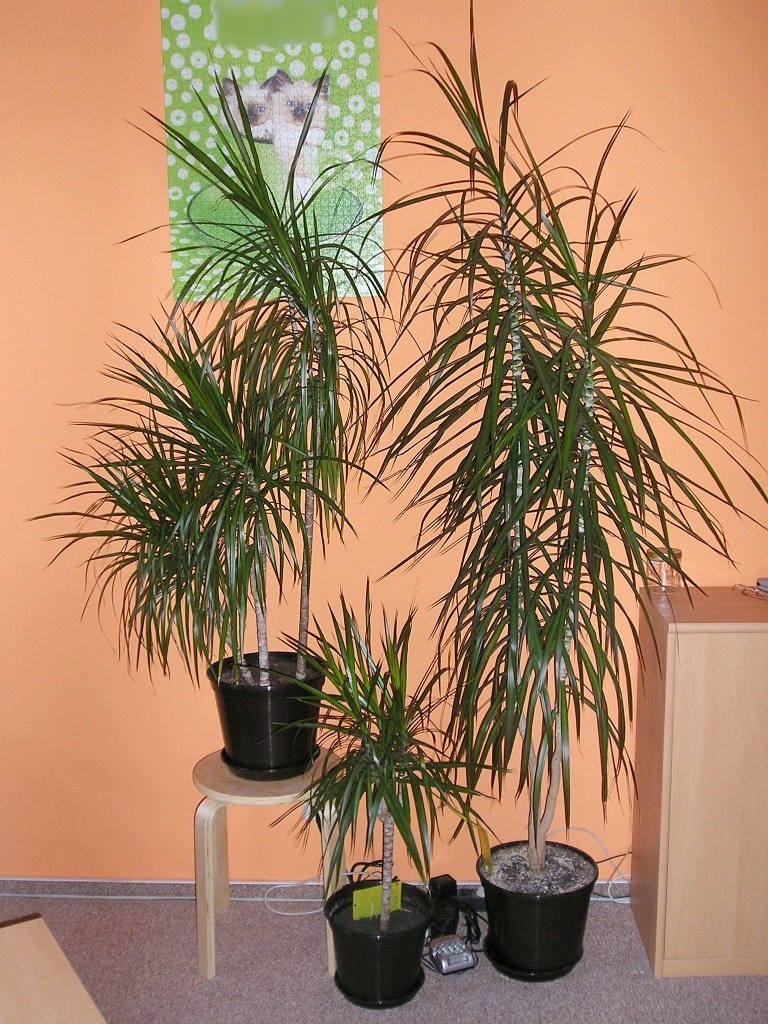
By itself, any dracaena plant is not capricious. The most undemanding are dracaena godseff, marginata, dragon tree. Most do not like too bright sun and therefore grow best in partial shade. In winter, an acceptable temperature is 15-12 degrees, but any dracaena listed above can withstand lower temperatures. Care during watering dracaena can be done with regular spraying. Since dracaena is a plant of a humid climate, they can be placed on wet pebbles or wet peat.
Only two types of dracaena tolerate dry air well: marginata and dracaena godseff. Look closely at the leaves of the dracaena, the tips have turned yellow, which means that the plant lacks moisture. The plant must be sprayed and the earthen coma should not be allowed to dry out. Another reason for this phenomenon may be a draft or cold air. If the lower leaves began to slowly die off, there is no reason for concern, this is a natural process. Top dressing with complex fertilizers is desirable to be carried out once every two weeks in summer, and in winter - once a month.
Dracaena are transplanted every two years in the spring. The plant is transplanted only when the pot has become small. The land necessary for dracaena can be purchased at the store or you can make it yourself from leafy soil, soddy soil, a little sand and humus. Dracaena, which will be cared for according to the specified requirements, will grow without problems.
Reproduction of dracaena
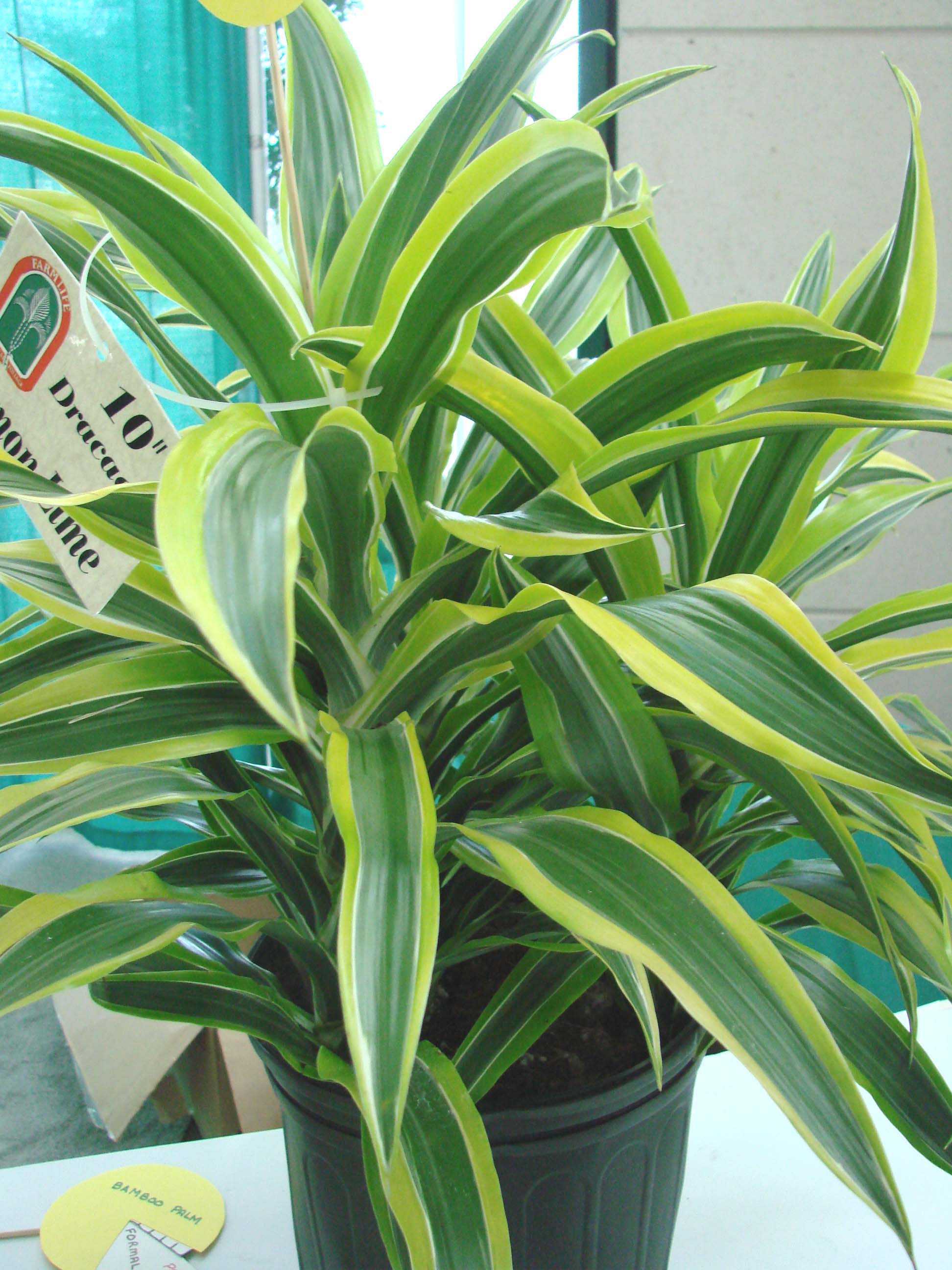
Reproduction of dracaena can take place in several ways.
Firstly, you can put a cut off top with a bunch of leaves in a jar of water, at the bottom of which there is a squeak. Put the jar in a warm place. The same apical process, after treatment with phytohormones, can be rooted in a wet squeak using lower heating.
You can also root cuttings cut from the stem. They are long, should be 5-7 cm. You can also root the top of the dracaena without cutting the stem using air layers. With this method, an incision is made below the leaves to half the trunk and a match is inserted so that the trunk partes a little. Then take a small pot and cut it lengthwise. Either a slot is cut out from the side, fixing the pot on the trunk of the dracaena in the place of the cut, loose earth is poured into it, which is often watered. Wet moss can replace an additional pot. The plant is separated from the uterine trunk after roots appear within a month. As you continue to water the old plant, new layers appear at the cut site. You can leave the plant in this form, or the new stem remaining after separation can be used as cuttings.
Diseases and pests of dracaena
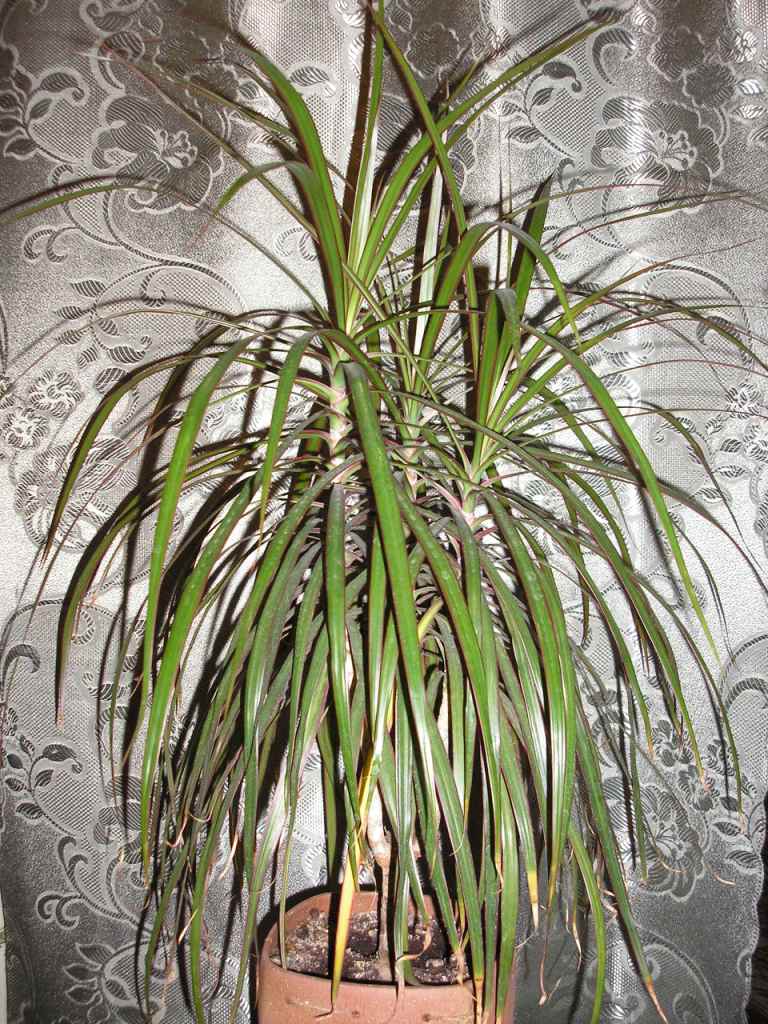
Dracaena rarely gets sick with proper care. Dracaena may appear light dry spots as a consequence after firing in direct sunlight, or the leaves may dry with little watering. As for pests, dracaena is most often affected by scale insects (brown plaques on the underside of the leaf). You can remove the scale insect with soapy water, after which the plant is treated with an insecticide, with a large pest damage, this procedure is repeated weekly. Spraying with insecticide also fights spider mites.
Fragrant dracaena is a shrub plant with a pleasant pronounced aroma. Due to its evergreen foliage, this plant cleans the air well. Peduncles grow 1 meter long, and flowers bloom at their ends. Inflorescences can be of two shades: white and light green, but indoor bushes bloom infrequently. The leaves are green with light green or yellow veins. If you grow a bush in a room, then in total its height is up to 2 meters.
The genus dracaena has about 40 species. The most common among them:
- Surprise;
- Fragrant, also known as Fragrans (Dracaena Fragrans);
- Canarian, it is also called the Dragon Tree.
Surprise ( Surprise)
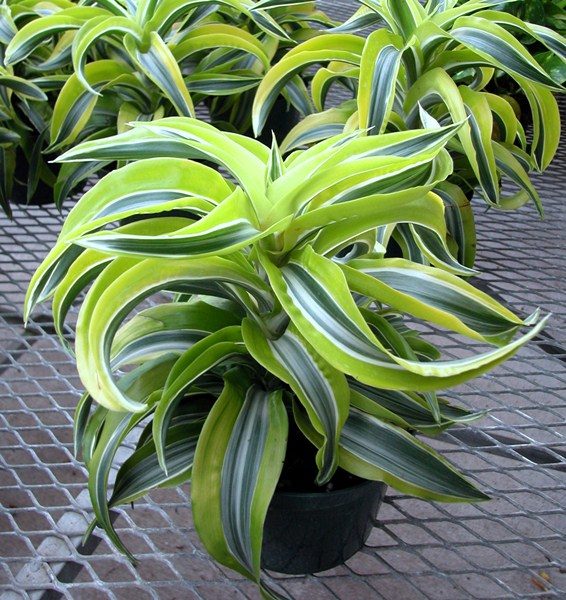
The most catchy and unusual variety. It is a dwarf plant only 20-40 cm high., including the crown of the bush, and combines two shades of green, as well as pure white. Surprise leaves are elliptical in shape with elongated, slightly curled ends.
Fragrant or Fragrans (Fragrans)
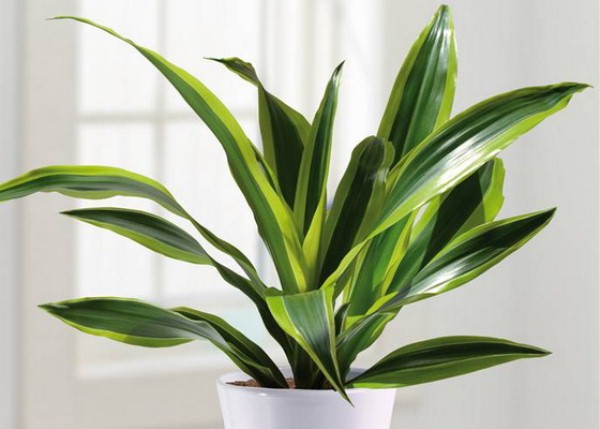
At home, the height of the Fragrans is limited to one or two meters, while in the natural habitat it can reach 6 meters. The leaves are glossy with an arcuate curved shape and have a variety of stripes in color..
Canarian ( Dracaena draco)
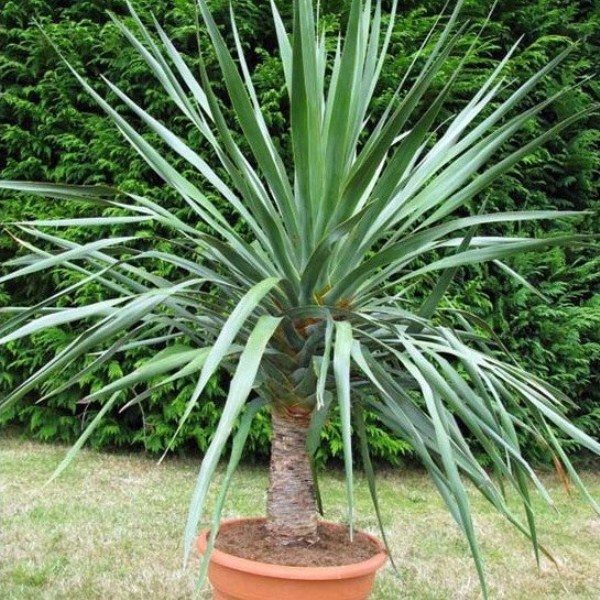
dragon tree indoors does not grow higher than one and a half meters, the leaves are long xiphoid and connected by bunches.
flowering plant
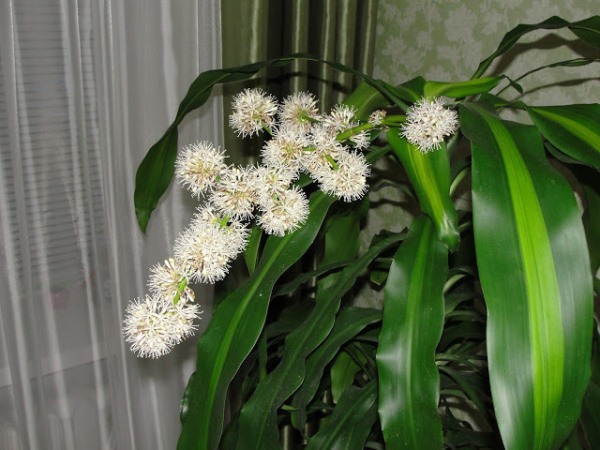
At home, it blooms very rarely, but in the presence of a special climate, it can still please gardeners with fragrant flowers. They open during the night, spreading a strong aroma, and in daytime days - closed, and the smell is almost not felt.
tree of happiness
In the common people, dracaena is called the "tree of happiness", which is not surprising, because this plant has a very romantic legend. To marry the daughter of a priest, an Aztec warrior had to grow a flower from a stick in five days.. Otherwise, he will fall into the sacrificial fire. But the love was so strong that a leaf still grew on the stick and saved the warrior from inevitable death. This was the dracaena, which is commonly called the "tree of happiness."
Care
The birthplace of the tree is the tropics, so it should have appropriate lighting. Windows facing east and south - the most advantageous location for a flower. But even in a dark place, the bush will continue to grow. The main thing is to avoid drafts and sudden changes in temperature.
The optimum temperature in the summer season: no more than +30, in winter - no lower than +10.
Choosing a flower pot is important, but not the most problematic. Many people think that it is better to take a ceramic pot, but this is not entirely true. Ceramic is only superior to plastic if there are no drainage holes in the plastic vessels.
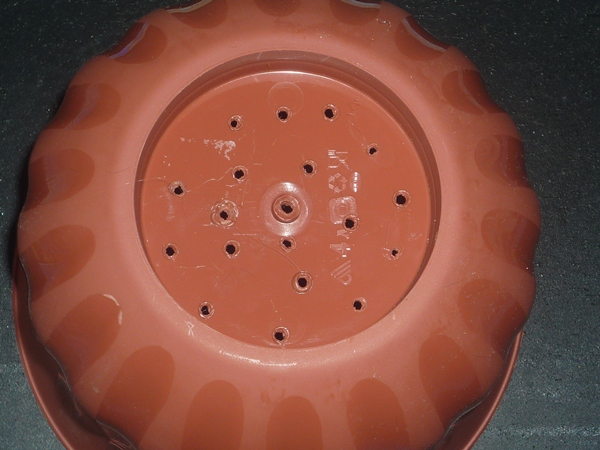
But glazed pottery should be avoided, as such a pot loses all drainage characteristics. The diameter of the pot should be slightly larger than the root system, and the depth should be about 1.5 - 2 diameters.
The main requirement for a flower pot is the presence of a good drainage system.
It is not very whimsical in watering, it is enough to water it twice a week in summer, and once a week in winter.. But it is advised to regularly moisten the leaves from a spray bottle with filtered water, thereby creating a semblance of water mist. It is important to ensure that water does not remain on the leaves for a long time. In case of moisture stagnation, it may die.
Quality soil is the key to good development. That's why soil mixture for dracaena Fragrant should consist of three types of earth: compost, deciduous and sod. Also in the pot should be the presence of clean coarse sand and peat. Combining all these components in the same ratio, you get the perfect soil.
To prevent root diseases, charcoal is added to the pots.
To feed the flower, they use special purchased fertilizers for palm bushes or dracaena. Starting from March and ending in September inclusive, the flower is fertilized twice a month. At other times - no more than once a month and half the dose.
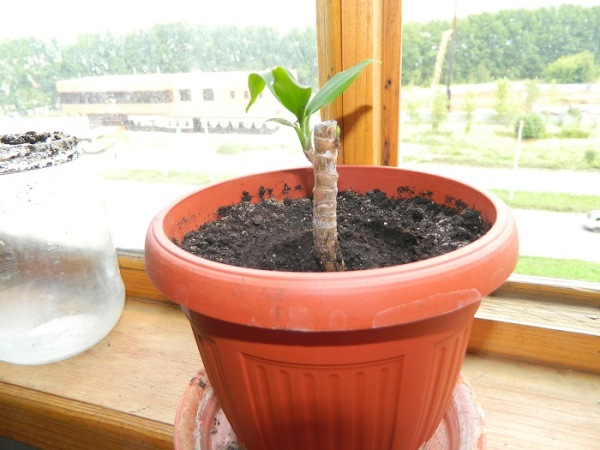
Very often, a multi-stem tree is formed from a single-stem tree. Such manipulations are best done in summer or spring, when the plant is actively growing and developing. The upper part of the bush is carefully cut with a knife or garden pruner 15 cm below the foliage. The resulting stump is sprinkled with ground activated carbon and rearranged in a warm, dark place. Once the foliage is removed, the dracaena absorbs little moisture, so it doesn't need to be watered often. New sprouts will germinate after a month.
Diseases and pests
The most common disease is hypothermia, which most often occurs in the winter season. If the flower is standing near a window or in a draft, then there is a risk of hypothermia of the root system and the flower itself. In this case, the tree may die. When the leaves of the dracaena begin to turn yellow, and their edges turn brown, this is the first sign of the disease. Then the leaves begin to curl and fall off. The next stage will be the rotting of the roots and stem.
For the treatment of the initial stage (yellowing of the foliage), it will be enough to move the plant to a warmer place, and after the yellow leaves have dried, they need to be cut off. Watering should be done carefully and occasionally sprayed. And here if the trunk becomes soft- this means that the dracaena has begun to rot. In this case, to save the tree, you need to act quickly. With a disinfected knife, you need to cut off all rotting areas, even if there is a stump from the whole plant (it will start new shoots with the advent of spring).
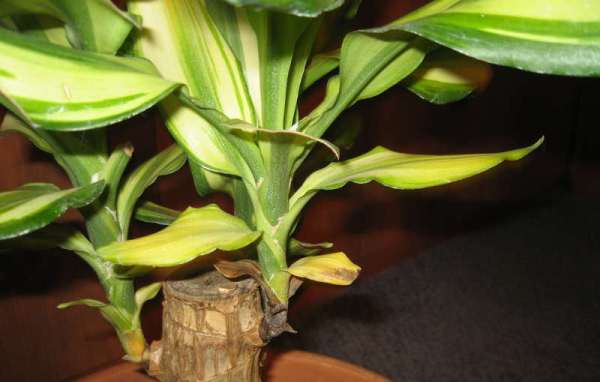
If the foliage begins to fall- this means that there is damage in the root system. In this case, you need to transplant the plant, after carefully checking the roots and, if necessary, letting them dry.
The appearance of yellow spots on the leaves and their drying indicates an insufficient amount of water during irrigation and too dry air. In this case, it is necessary to water the plant more intensively, as well as spray the foliage.
Like any plant, dracaena also may be affected by pests. These include thrips, aphids, spider mites, scale insects and mealybugs. It is worth fighting these pests with the help of specialized insecticides, which must be selected in strict accordance with the pest that infects the plant.
When using insecticides and pesticides for pest control, it is worth consulting with a specialist florist about the choice and use of the drug so as not to harm the plant.
Reproduction at home
There are three breeding methods for dracaena:
seeds
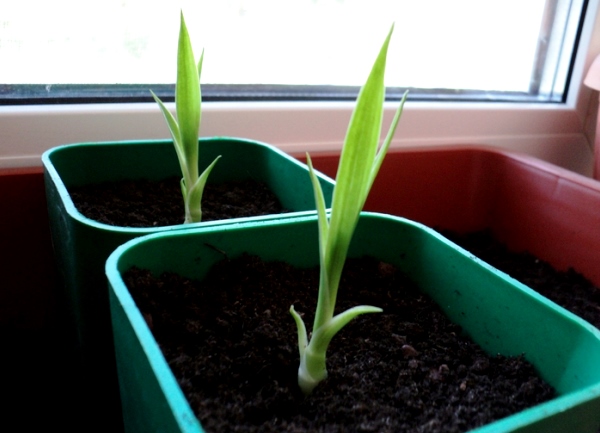
This method is applicable only for dracaena with completely green leaves. Seeds, before planting in the soil, should be soaked for a day in a Zircon solution to stimulate germination. It is important to strictly observe the required temperature. The air must always be heated to at least 30 degrees Celsius. After a day, the seeds are planted in special soil, and the container is covered with cling film. Seeds will begin to germinate in one to two months. Sprouts need to be fed once a month, and when they reach a height of 5 cm, transplant them into a permanent pot.
cuttings
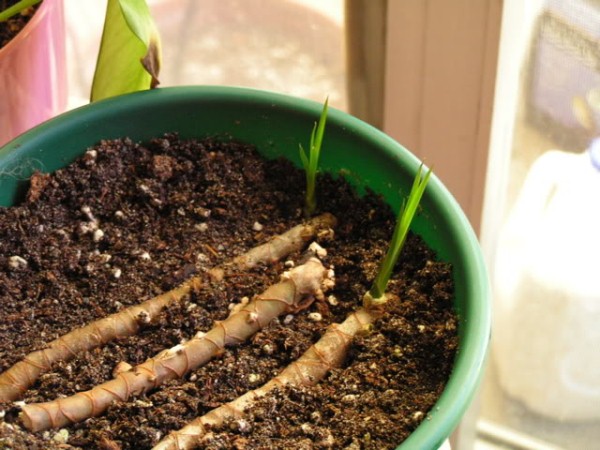 KONICA MINOLTA DIGITAL CAMERA
KONICA MINOLTA DIGITAL CAMERA This method consists in cutting off a young healthy stem. After that, it must be carefully cut into pieces up to 5 cm long. On pieces of the stem, make an incision in the bark and stick into the soil. By covering the flower with a jar or plastic bottle, you can make a greenhouse. Sprouts should be kept in a warm place. The first shoots begin to germinate after a month and a half. They must be periodically sprayed with filtered water from a spray bottle.
Layering from the top of the plant
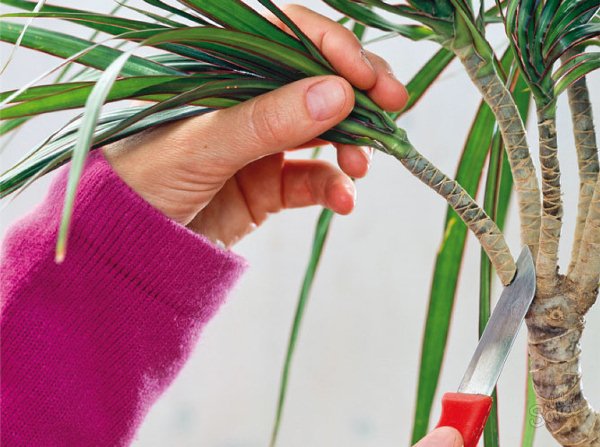
The cut off top of the dracaena is placed in a container with water in which an activated charcoal tablet is dissolved. This method will be the slowest, since the plant will take root no earlier than three months later.. After that, the cutting must be planted in the ground. Also, the pot can be covered with a jar to create the effect of a greenhouse, which will allow the dracaena to take root better.
flower transplant
When buying a dracaena, you should carefully examine it. If the flower is young, then it can be transplanted into a new pot, but if the tree is already quite large, then the transplant should be postponed until spring. It is also worth asking the seller where the dracaena was brought from. Because a special substrate is used to transport plants over long distances, and in this case, the plant should be transplanted immediately.
Specially buying large pots "for growth" is not worth it. This will lead to stagnation of moisture in the soil, which negatively affects the plant. The best choice would be flower pots, the diameter of which is 2-3 cm larger than the current one.
Soil also needs to be selected special. He is a mixture of four components, which can be easily made independently, namely: two parts of soddy soil, one part of leaf, one part of compost soil and half of peat soil.
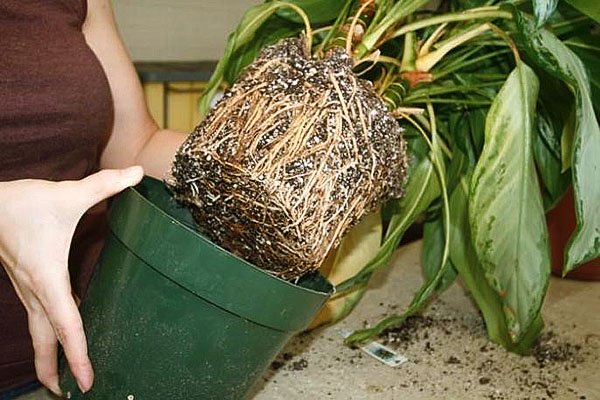
The transplant process itself should be performed in the following order:
- new floral wash pot with hot water;
- pot bottom cover with drainage;
- Carefully remove the plant from the old pot, carefully check roots(if rotten roots are found, remove them) and spray them with a spray bottle;
- Place the plant in a new container, gradually filling the soil mixture (carefully monitor the filling of voids with soil);
- After transplant pour water with the addition of Zircon fertilizer (subsequently, the plant should be fertilized no more than once every two weeks).
In general, dracaena is a beautiful, perennial, evergreen plant that pleases the eye with rich colors. In care, this plant is not picky, but with the onset of cold weather, it is worth making sure that the flowerpot does not stand in a draft and does not freeze. The plant does not cause difficulties in transplanting and reproduction. But in order for the dracaena to begin to bloom, you will have to make a lot of effort.